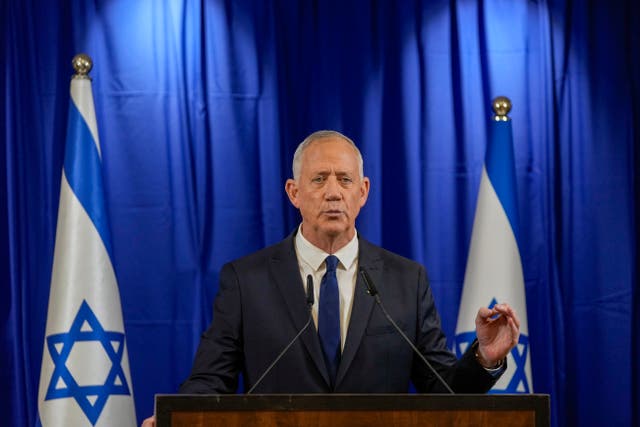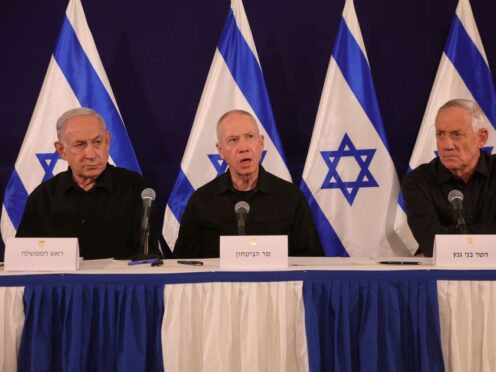Israeli officials have said that Prime Minister Benjamin Netanyahu has dissolved the influential war cabinet that was tasked with steering the war in Gaza.
The war cabinet was dissolved following the departure from the government of Benny Gantz, an opposition legislator who had joined the coalition in the early days of the war.
He had demanded that a small cabinet be formed as a way to side-line far-right legislators in Mr Netanyahu’s government.
Mr Gantz, Mr Netanyahu and defence minister Yoav Gallant were its members and made key decisions together throughout the war.
The officials, who spoke on condition of anonymity because they were not authorised to discuss the change with the media, said that going forward Mr Netanyahu would hold smaller forums with some of his government members for sensitive issues.
The War Cabinet was formed in the early days of the war, when Mr Gantz, then an opposition party leader and Netanyahu rival, joined the coalition in a show of unity following the October 7 Hamas attack on southern Israel.

The move to scrap the war cabinet comes as Israel faces more pivotal decisions.
Israel and Hamas are weighing the latest proposal for a ceasefire in exchange for the release of hostages taken by Hamas during its attack.
Israeli troops are still bogged down in the Gaza Strip, fighting in the southern city of Rafah and against pockets of Hamas resurgence elsewhere.
And violence continues unabated between Israel and the Lebanese Hezbollah militant group — with a Biden administration envoy in the region in a bid to avert a wider war on a second front.
Mr Netanyahu has played a balancing act throughout the war between pressures from Israel’s top ally, the US, and the growing global opposition to the war and from his government partners, chief among them finance minister Bezalel Smotrich and national security minister Itamar Ben-Gvir.
Both have threatened to topple the government should Israel move ahead on a ceasefire deal. The latest proposal being considered is part of the Biden administration’s most concentrated push to help wind down the war. For now, progress on a deal appears to remain elusive.
Critics say Mr Netanyahu’s wartime decision-making has been influenced by the ultranationalists in his government and by his desire to remain in power.
Mr Netanyahu denies the accusations and says he has the country’s best interests in mind.
Mr Gantz’s departure, while not posing a direct threat to Mr Netanyahu’s rule, rocked Israeli politics at a sensitive time.
The popular former military chief was seen as a statesman who boosted Israel’s credibility with its international partners at a time when Israel finds itself at its most isolated. Mr Gantz is now an opposition party leader in parliament.
Mr Netanyahu’s government is Israel’s most religious and nationalist ever. In Israel’s fractious parliamentary system, Mr Netanyahu relies on a group of small parties to help keep his government afloat and without the support of Mr Gantz’s party, Mr Netanyahu is expected to be more beholden to the far-right allies.
Also on Monday, a top US diplomat tasked with quelling tensions between Israel and the Lebanese militant group Hezbollah arrived in Israel for talks with Mr Netanyahu.

Amos Hochstein, a senior adviser to US President Joe Biden, arrived at a time of heightened tensions between Israel and Hezbollah. Few details were made public about the visit, which was announced by Mr Netanyahu’s office.
Hezbollah began attacking Israel almost immediately after the Israel-Hamas war erupted on October 7.
Mr Hochstein is expected to travel to Lebanon from Israel.
On Monday, Lebanon’s state-run National News Agency reported that an Israeli drone strike on a car in southern Lebanon has killed a member of the Hezbollah militant group.
The airstrike came as Hezbollah has not claimed any attack on northern Israel since Saturday night apparently because of the Muslim feast of Eid al-Adha that began on Sunday morning.
Hezbollah issued a statement later on Monday identifying the member killed in the drone strike near the village of Chehabiyeh as Mohammed Ayoub.
